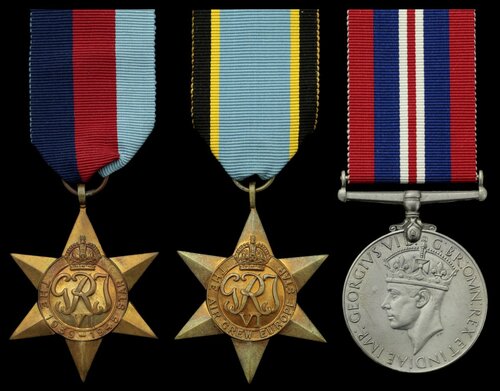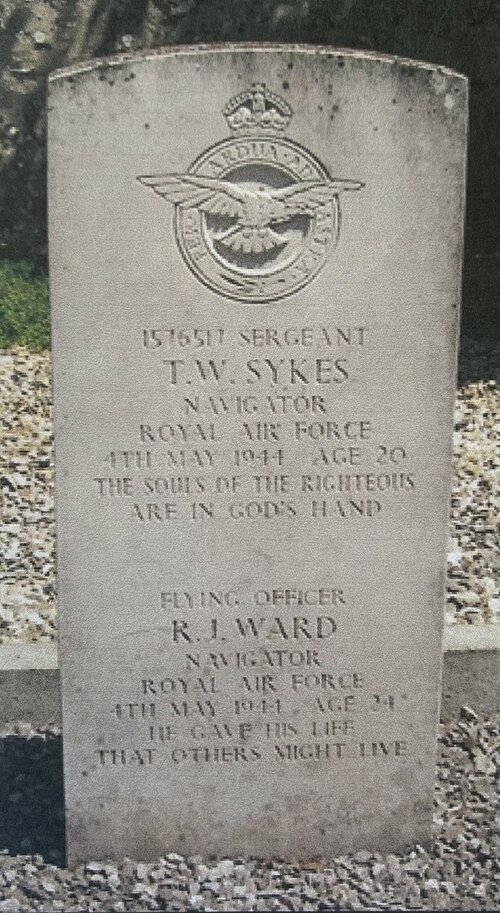Auction: 21002 - Orders, Decorations and Medals
Lot: 149
Three: Sergeant (Navigator) T. W. Sykes, No. 103 Squadron, Royal Air Force Volunteer Reserve, who was killed in action on his first Op when his Lancaster was shot down over Beauchery-St.-Martin whilst on a bombing raid to Mailly-le-Camp, on 3-4 May 1944
1939-45 Star; Air Crew Europe Star; War Medal 1939-45, with named Air Council enclosure and medal ticket, in card box of issue, addressed to ‘W. Sykes Esq., 24 Cartwright Road, Northampton.’, extremely fine (3)
Terence William Sykes served during the Second World War as a Navigator with No. 103 Squadron, joining with his crew directly from 11 Base on 13 April 1944, and was killed in action on his first operational sortie when Lancaster ND411, piloted by Pilot Officer J. E. Holden, was shot down and crashed over Beauchery-St-Martin, whilst on a bombing raid to the German military base at Mailly-Le-Camp, on 3-4 May 1944. All the crew were killed.
The Bomber Command War Diaries by Martin Middlebrook states:
'Late on 3 May 1944, 346 Lancasters of 1 and 5 Groups along with pathfinder Mosquitoes attacked the large German military base at Mailly-Le-Camp. The control of this raid in the target area failed to operate according to plan. The initial low level markers were accurate and well backed up by Lancaster marker aircraft. The Marker leader (Wing Commander G. L. Cheshire) ordered the main force to come in and bomb but the main force Controller (Wing Commander L. C. Deane) could not transmit the order to do so to the waiting Lancasters because his VHF set was being drowned by an American Forces Broadcast and his transmitter was wrongly tuned. German fighters arrived during the delay and bomber casualties were heavy.
The main attack eventually started when Deputy Controller (Squadron Leader E. N. M. Sparks) took over.
Approximately 1500 tons of bombs were dropped with great accuracy. 114 barrack buildings, 47 transport sheds and some ammunition buildings in the camp were hit; 102 vehicles including 37 tanks were destroyed 218 German soldiers were killed and 156 were injured. Most of the casualties were Panzer NCO’s. There were no French casualties but some were killed when Lancaster ND411 was shot down and crashed on their house.’
This was Sykes’ aircraft which was homeward after the raid but North of its tracked course. There has been some dispute over French soldier deaths held in the barracks.
The Australian Government publication, Invasion to Victory April 1944 to May 1945, states:
‘The people of Beauchery-St-Martin, a little village to the South East of Paris, also had good reason to remember the night of 4-5 May 1944. Rachel De Boisgelin, the American born wife of a local landowner, was woken up by the noise:
“Many of us living near were awakened by a tremendous roar of motors, by firing and then the sky was lighted up for miles around by explosions. But at that time the Germans were masters here and anyone who stepped out of a house before five in the morning risked being shot. By the noise and the glow in the sky, when the planes came down the Germans knew what had happened and they were looking at everything before anyone else. It gives me grief to tell these painful details but the planes caught fire which made identification of those who were in them extremely difficult”
RAAF Flight Sergeant Clifford Gay was in one of the planes, Lancaster ND411 of 103 Squadron. Two Lancasters came down very near to each other and of the 15 crew only one survived. The remains of the others were placed in five coffins and were buried by the villagers in a collective grave in the Beauchery Communal Cemetery.’
A local teacher, Simone Rustang wrote to the sister of Sergeant James Moore, the flight engineer in Sykes’ aircraft:
‘Never has our village seen such a big crowd - 1800 to 2000 people. At that lovely time of the year there were plenty of lilacs and lilies of the valley also tulips and rarer flowers. The five coffins disappeared under the tulips and whilst they were all being taken to their last resting place in this peaceful corner of the cemetery where the grass often grows, we were thinking of their families who might be thinking of them alive somewhere in Europe.’
Sykes is buried in a joint grave, with Flying Officer Ward, alongside his crew in Beauchery Communal Cemetery, France. His medals were sent to his father, William Sykes.
Sold with copied research.
Subject to 20% VAT on Buyer’s Premium. For more information please view Terms and Conditions for Buyers.
Sold for
£380
Starting price
£240







